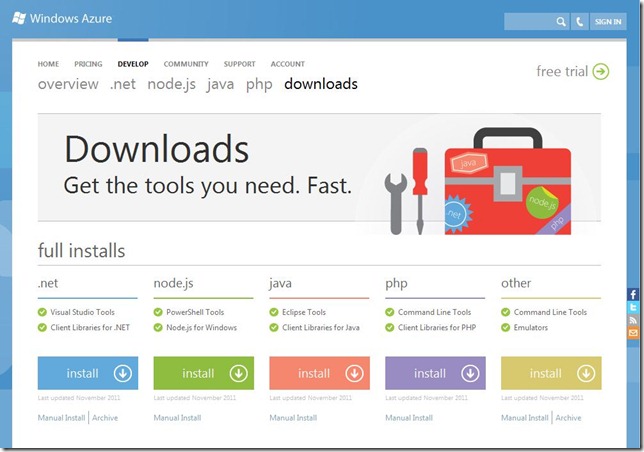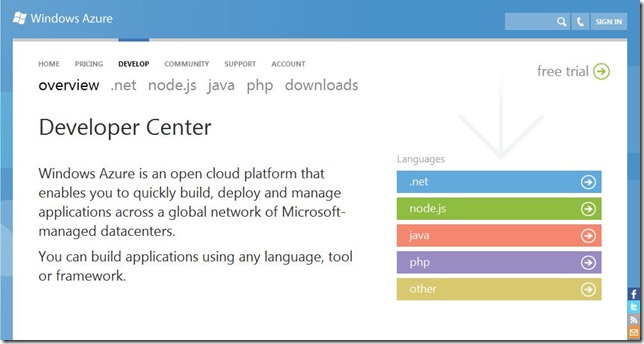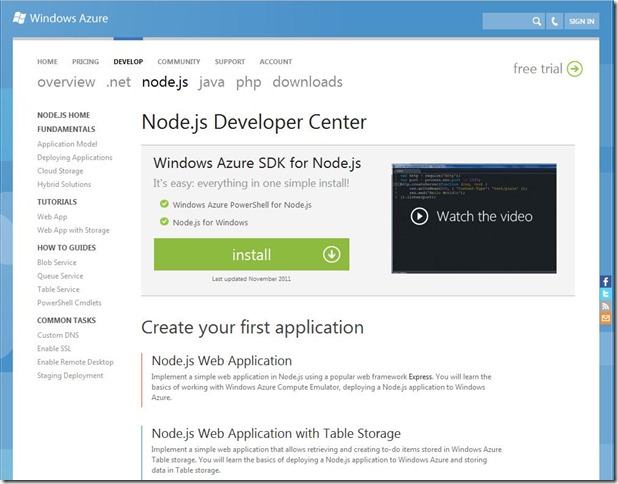New Developer Centers on WindowsAzure.com
On December 10, 2011, a new version of WindowsAzure.com went live. There are many improvements and a ton of new things to check out. My teammate Jim O’Neil recently covered a key improvement in getting started with The New, Improved No-Risk Windows Azure Trial. (Do read it as a step 1 to this post!) In this post, I want to cover one of the areas I’m personally excited about: The new Developer Centers.
Windows Azure has been an open platform since it first went into production service in January 2010. However, many have had a perception that it is a .NET-only cloud solution. Why has that perception been out there? Well, likely because anyone who visited WindowsAzure.com in the past would notice that the site was very .NET-centric. Links, documentation, tools, etc were all focused on the .NET development platform.
.NET ROCKS! (If you don’t believe me, ask Carl & Richard.) But, .NET is not the only development platform in the world. There are many other development languages and platforms out there that run on Windows, and thusly, Windows Azure. However, if you wanted to try and use a non-.NET platform on Windows Azure, you found yourself clicking tiny links, virtually hidden on the home page, that would lead you off to a “web ghetto” of sorts to get the tools and SDKs needed for these platforms. (That is… IF you could even find those links.)
It was clear that .NET was the first-class citizen, and all other platforms were 2nd and even 3rd class citizens. With the new WindowsAzure.com, that situation is on the way to being rectified.
Introducing the Windows Azure Developer Center: Imputing All Platforms As Equal
I’ve recently been reading the new Steve Jobs biography by Walter Isaacson. (Hoping to wrap it up over the holidays!) One thing that stuck with me from the book is the notion of “imputing value”. In an early passage of the book, Isaacson covers how one of Jobs’ first mentors at Apple, Mike Markkula, instilled in Jobs the importance of “imputing value”. In a one-page paper written in the early days of the company called “The Apple Marketing Philosophy”, Markkula listed “impute” as a key principle.
“It emphasized that people form an opinion about a company or product based on the signals that it conveys. “People DO judge a book by its cover,” he wrote. “We may have the best product, the highest quality, the most useful software, etc; if we present them in a slipshod manner, they will be perceived as slipshod; if we present them in a creative, professional manner, we will impute the desired qualities.”"
This concept of imputing value came up repeatedly throughout the book as it covered the early history of Apple. Essentially, it’s all about appearances. Even if you don’t have a solid product/service/company/etc, you present yourself as though you do. Think of it like wearing a suit to a job interview, even though you may only wear jeans and t-shirt if you end up working there. You wear the suit because a suit “imputes” YOUR value, conveying the message that YOU are a valuable resource. (And that you actually want the job!)
Windows Azure is a solid service from a solid company. It’s the reason I decided to jump at the opportunity to focus on Windows Azure here at Microsoft. Anyone who knows me, knows that I have a history of going against the grain and connecting non-Microsoft stuff with Microsoft stuff. Using technologies other than .NET on Windows Azure is something that has interested me for some time now.
While Windows Azure certainly has spent its early days focused on the .NET space, there has been a lot of investment going on behind the scenes to broaden its focus. Those investments have started to manifest themselves with the new Windows Azure features and website that went live on December 10, 2011.
Now, when you visit Windows Azure.com, there is one Developer Center that presents all of the platforms as equal contenders for use on Windows Azure. This is great, because Windows Azure truly is an open platform, open to all comers. Now, Windows Azure is finally saying it to the world.
When I saw the new Developer Center, I thought, “Wow! This finally imputes value for other platforms at first glance!”
Java developer? Node developer? PHP? Come on board! You’re welcome, and we’d love to see you developing applications on Windows Azure!
On the main developer center page, there are clear links (all of the same size, fonts, etc) to a developer center for each language and/or developer platform. There are four introduced with this new site update: .NET, Node.js, Java, and PHP. There is also an “Other” which leads you to details on the RESTful/HTTP APIs so you can use Windows Azure and its services from other platforms which don’t yet have formal developer centers.
When you visit an individual developer center, you find all of the information you need to get started with Windows Azure for that platform. Links to downloads, links to documentation, etc. It all looks consistent across the board. Below is an example of the Node.js Developer Center:
On the Downloads page, there are clear links to get the bits for each platform too:

In addition to organizing things better, the Windows Azure team has made it easier to see the code. The Windows Azure SDKs for .NET, Java, and Node.js have been released under the Apache 2 open source license and are now hosted on GitHub! The source code for the Windows Azure SDK for PHP, which has long been released under a New BSD license, still resides on CodePlex.
A Good Start
The new Developer Center sets the stage, making it easy for a developer on any platform to get started with Windows Azure. However, the tools, documentation, and SDKs are in various states for each language. All have been improved from previous versions. Some have more work to be done. For example, some things still link through to perfectly good pre-existing content (as is the case for a lot of the PHP content).
The future direction is clear from the revamp of the site, and the introduction of the new SDKs for Node.js and Java: Windows Azure is open to all players. I look forward to future changes over time as the site continues to be updated. For now, it’s a start, and it looks great!
Check the new Windows Azure developer centers out. Have a look around and let me (and the Azure product team) know what you think!


